In Hopi belief, if you want to teach a person the history or the song that is deeply connected to our history, you feed them corn. You’re planting history into this person. Planting is really a life of Hopi.
Milland Lomakema, Hopi, 1986
The Hopi people farm successfully in an arid and demanding environment. They have detailed knowledge of their environment and employ specialized agricultural methods to maximize their chances for success. Farmers select the most favorable field sites on the valley floors, generally utilizing naturally flooded areas such as the mouths of large washes to capture the runoff from heavy thunderstorms. They plant multiple seeds in each hole, resulting in clumps of plants that are wind resistant and widely spaced to prevent soil nutrient depletion. Seeds are planted 12 inches deep to take advantage of the moisture trapped in the sandy subsoil.
The traditional planting dates are determined by the Sunwatcher, who observes the varying positions of the rising sun on the horizon. With the worrisome potential for both late spring and early fall frosts, correct timing for planting is vital. Hopi farmers increase their chances for success by making several plantings at different locations, elevations, and times.
The Hopi people place high value on traditional corn horticulture techniques and continue to exert great effort in the application of these centuries-old practices, using native seeds and organic farming methods. Farming has more than economic significance. Working the corn is an act of faith.
Corn has sustained the people for centuries and continues to be an essential element in every ceremony. Although people may supplement their supply with corn purchased from the supermarket, it is the presence of corn cultivated by the Hopis themselves that is of primary importance.
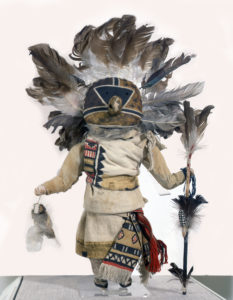
Germination Katsina: Ahöla Tihu
Hopi peoples, Arizona, ca. 1904
Cottonwood (Populus sp.), commercial cotton, Golden Eagle wing covert feathers (Aquila chrysaetos), Black-billed Magpie feathers (Pica pica), Wild Turkey feathers (Meleagris gallopavo) unidentified feathers, cottontail? fur (Sylvilagus sp.), horsehair (Equus caballus), commercial wool, paint, dye; W 40.0 x H 59.7 cm; 3165-109
Ahöla, a winter solstice Katsina, arrives to open the kivas for the other Katsinas' visitations. He blesses all the houses in the village and the seeds that each household will plant in the upcoming agricultural season.
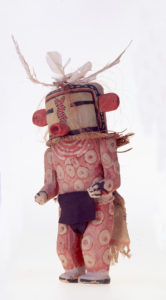
Spotted Corn Katsina: Avatshoya Tihu
Hopi peoples, Arizona, ca. 1904
Cottonwood (Populus sp.), commercial and mineral paints, commercial cotton, clay, commercial wook, unidentified feathers, juniper branch (Juniperus communis), horsehair (Equs caballus), cotton cord (Gossypium hirsutum), commercial dye; H 11.4 in. (16.5 W x 29.0 H cm); 3165-90
Corn Katsinas are the most common of the plant impersonators. This tihu is covered with spots that represent kernels of corn.
Plant Kachinas literally bring their own water. If there is no moisture, there are no plants, and by extension should there be no plants, there will be no Hopi. Small wonder that the Corn Kachinas are so popular both in song and in dance.
Barton Wright, 1977
The Desert Southwest
People have been living in the Southwest region of the United States for at least 10,000 years. Faced with the hardships of life in an arid land, these peoples developed cultures that relied on the area's natural resources.
The Southwest is a land of mountains, deserts, plateaus, mesas, and deep canyons. In places, it rises above sea level to altitudes of 5,000 to 7,000 feet. Throughout the region, rainfall averages less than 10 inches per year, and there are few permanently flowing rivers. The lack of both rain and flowing water makes survival extremely difficult.
Despite the harshness of the environment, many forms of plant and animal life have adapted to it. Many varieties of plants are indigenous to this region, including roots, grasses, plants and cacti. Juniper and piñon trees are also scattered throughout the area. Rabbits, rodents and reptiles are quite abundant. In some places, larger animals such as deer, antelope, bear, foxes, and coyotes can be found as well.
By using the plants and animals that were available to them and by developing practices that realized the land's full potential, the Hopi people adapted to a high-plateau desert way of life.
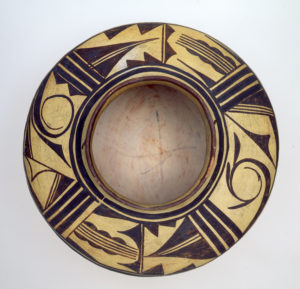
Seed Jar
Nampeyo?, Hopi peoples, Arizona, early 1900s
Clay, vegetable and mineral (hematite) paints; H 9.0 x D 29.0 cm; 14367-9, gift of Miss E. Bertha Hewitt
Special jars are used to store carefully selected melon, pumpkin, sunflower, and bean seeds until planting time. These pottery jars have broad shoulders and narrow openings that can be stoppered to keep out insects and rodents.
Desert Agriculture
The Hopi peoples live on land that is both beautiful and majestic, but the environment presents enormous problems for those dependent on farming. The Southwestern region is extremely dry with little water. A number of permanent springs in the area provide the people with drinking water but do not supply enough water to irrigate fields. No permanent rivers or streams flow through Hopi territory.
Erosion and overuse of the land has diminished the region's plant life. The land of the Hopi now mainly consists of dry grasslands and mesas. The land supports a variety of plants adapted to extremely dry areas, while the canyons - punctuated with springs, washes, and occasional streams - support cottonwood, willow, and cattails.
Rain is the only source of water for the Hopi farmlands, but rain alone cannot support the Hopi. Annual rainfall averages less than 10 inches per year. In some years, drought causes the crops to fail. In other years, torrential summer downpours drown the young and growing plants. The people hope for a season of balanced precipitation.
The Hopis' survival has been inextricably bound to favorable weather conditions. In the scattered areas of fertile soil, the Hopi grow corn, pumpkin, beans, chile peppers, peaches, gourds, watermelons and squash, looking to the Katsinas to favor them with rain.
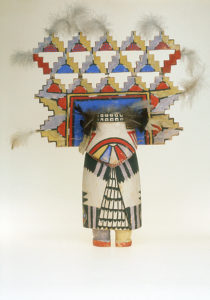
Salakmana Katsina
Hopi peoples, Arizona, ca. 1904
Cottonwood (Populus sp.), unidentified wood, commercial and mineral paints, laundry blueing, Wild Turkey feathers (Meleagris gallopavo), unidentified large owl feathers, unidentified feathers, steel, unidentified resin, commercial dye; W 57.0 x H 65.0 cm; 3165-168 (doll), 3165-302 (headdress)
Clouds and rain are frequent motifs in all Hopi imagery. Rain clouds are regularly depicted as stylized terraced triangles, often with vertical stripes of rain showering from them.
The Salakmana girl, or maiden, wears lots of clouds in her headdress. On her forehead is an ear of corn, the logical outcome of the rain she brings. On rare occasions following the Niman Ceremony, the Salakmana male and female pair will make an appearance together. This Katsina is an unusually large and elaborate example.
Corn Planting and Preparation
In the autumn the corn is harvested and spread out, sometimes on rooftops, to dry in the sun. The ears are then stacked like cordwood in storage areas to be used throughout the year until the next season’s crop is ripe. After the dried kernels are shelled, they are boiled or ground into meal.
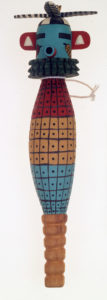
Corn Katsina: Ahulani/Kä-e Tihu
Merrel Yaira, Hopi, 1996
Unidentified wood, commercial paint, commercial cotton cord; H 30.0 cm x D 9.0 cm; 36177-6
Tihus, commonly called Katsina dolls, are wooden sculptures of the Katsina spirit beings. The introduction of the tihu with the body of an ear of corn is relatively recent. Such dolls may have a head that represents any Katsina, thus Katsinas and corn become linked together in this carving.
Katsina is the spelled preferred by the Hopi, although Kachina is the spelling most often found in the English literature.
